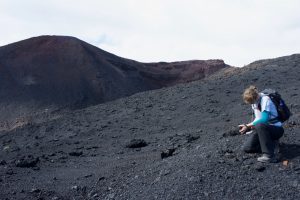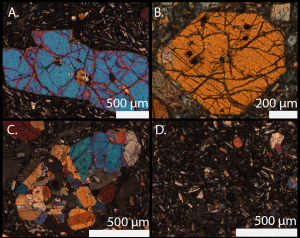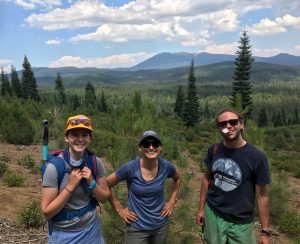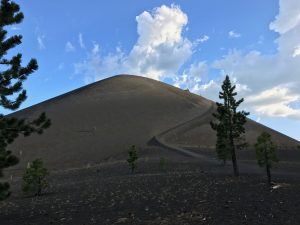Research
I recently moved to Western Washington University!
Get to my new website here!
Volatile Cycles in the Mantle
Currently, my work is focused on understanding volatile cycling and heterogeneity in the deep mantle by analyzing the B-isotope composition of basaltic magmas at endmember ocean islands. In this study, we aim to analyze the B isotope composition of melt inclusions and basaltic glass from ocean island basalts (OIB) by ion microprobe as part of a NERC consortium titled ‘Mantle volatiles: processes, reservoirs, and fluxes.’
See our recent results, published in EPSL:
Sampling at Volcan Teneguia, La Palma, Canary Islands
Pre-eruptive storage, evolution, and ascent timescales of a high-Mg basalt in the southern Cascade Arc
Much of my research with Middlebury College geology students is focused on cinder cone magmatism in the southern Cascades – specifically, utilizing the major and trace element composition of olivine and pyroxene to determine pre-eruptive storage, evolution, and ascent timescales.
Photomicrograph of olivine and pyroxene phenocrysts from a typical Lassen basaltic lava
Collecting samples at Red Mountain, Lassen County, CA
Magma formation beneath the Cascade Arc
In subduction zones, the mantle is thought to be fluxed by fluids and/or melts derived from the downgoing plate, which lower the mantle solidus, producing melts that rise through the continental crust and form arc volcanoes. However, beneath the Cascade Arc subducts some of the youngest, and consequently warmest oceanic crust globally, and temperatures predicted by geochemical and geodynamic models suggest little to no H2O may reach sub-arc depths to initiate melting.
Lassen Peak, Lassen National Park, CA
How does the subduction of warm oceanic lithosphere influence dehydration reactions in the slab and melt production in the mantle wedge? To answer this question, I have focused on the compositions of olivine-hosted melt inclusions from primitive basalts in the Lassen Region (southermost active segment) of the Cascade Arc. By measuring the volatile (H2O, CO2, Cl, S, and F), major element, trace element, and stable isotopes (δD, δ11B, and δ18O) compositions of these melt inclusions, we hope to better understand the processes that govern how magma forms in the hot-arc setting.
And an excellent summary of our published work here, thanks to Ars Technica: http://arstechnica.com/science/2015/04/magma-beneath-the-cascade-volcanoes-might-be-special-blend/
Plumbing system evolution of monogenetic volcanoes
Cinder cones are the most abundant volcanic landform on earth. In the Lassen area alone, over 500 monogenetic cinder cones and small shield volcanoes have erupted in the last 12 Ma, representing the largest percentage of total erupted volume in the southern Cascades. Despite the abundance of monogenetic volcanoes in the Cascades and consequently, their likelihood to pose volcanic hazards in the northwestern United States, these types of volcanoes are vastly understudied, especially when compared to more evolved and longer-lived stratovolcanoes.
Cinder Cone, Lassen Volcanic National Park, CA
Previous work focused on a cinder cone named Cinder Cone (which erupted in 1666) and current work is focused on Poison Butte, both in the vicinity of Lassen Volcanic NP, California. Here, my research students and I are exploring the composition of olivine-hosted melt inclusions and the physical volcanology of the beautifully preserved tephra stratigraphy. By coupling melt inclusion chemistry with bulk tephra analyses and physical volcanology, we aim to understand pre-eruptive storage and evolution of the magmas, in addition to determining the explosively of past cinder cone eruptions in this region.
For more info on fieldwork related to this topic, check out the article in the Middlebury News: Volcano Researchers Take to the Field in Lassen Volcanic National Park.




